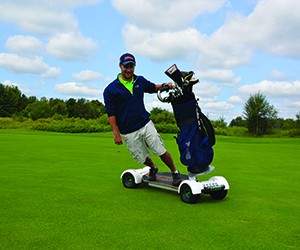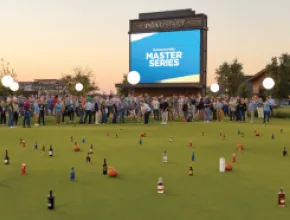Golf may have waned in popularity with some groups, yet a well-planned golf event is still one of the best ways to establish long-lasting relationships, enjoy friendly competition in a relaxed environment, interact with potential clients and promote teambuilding.
To plan and execute a successful golf event at a golf-centric resort requires acute attention to detail and the acquired knowledge to ask the right questions and address pertinent issues.
“The biggest issue today in golf is pace of play,” said Bryan Johnson, golf sales manager for Silverado Resort & Spa in Napa, Calif. “Realistically, all resorts are in the business to create a memorable experience and target a pace of play at four to five hours.”
To keep within that time parameter, planners should select courses that promote faster play to stay within the time block highlighted on the itinerary, which ultimately makes all attendees happy.
Course Concerns
What types of golf courses encourage faster play?
“The less severe the golf course in terms of trouble like water hazards, heavy rough, excessive greens speeds, out of bounds and excessive bunkering, the better possibility for a good pace of play,” said Tim Cusick, director of golf instruction for Four Seasons Resort and Club Dallas at Las Colinas in Irving, Texas. “Golf courses that don’t have long distances between greens and the next tee box also help in reducing the time for a round of golf.”
Many golfers, especially novices, erroneously believe that longer golf courses are always more difficult.
“Although the length of a course can play a part in deciding which course a group should play, the actual playability of the course is the ultimate deciding factor,” said Jane Broderick, director of golf for PGA National Resort & Spa in Palm Beach Gardens, Fla., which has five championship golf courses. “Higher handicap groups have more fun on an open course with wider fairways and few water carries such as our Fazio course. They would not have as much fun on the Squire, which is actually our shortest course but requires pinpoint accuracy because of the narrow fairways.”
Broderick said one of the biggest factors impacting the pace of play and ultimate enjoyment for golfers is the course setup.
“Planners should consult with the golf director about the speed of the greens, pin positions and setting up appropriate tee settings for the group’s skill level,” Broderick said.
Some golf resorts have multiple courses, which allows planners to select the specific layout most suitable for the skill level of their group.
Johnson said after the golf course is selected, the most important concern is the type of format chosen for the tournament.
“A scramble format creates a much faster pace of play compared to an individual score event because you decide to hit the best shots out of the team,” Johnson said.
PageBreak
Time Savers
When your itinerary is packed with meetings and activities, and a four- or five-hour time block is simply not possible, incorporating a shorter event is a great way to still capitalize on golf’s many benefits.
Larger golf resorts typically have expansive practice areas with large putting greens, driving ranges with numerous hitting stations and golf academies with top-notch instructors, making it easier for planners to create and execute shorter events.
“Some of the events I like for groups with time-sensitive itineraries are breakfast, lunch or dinner with 9 holes, 18 holes of golf from the 150 to 175 yard markers, speed golf, a walking and running game where each player has only three clubs, and providing a teaching pro with each group for a set number of holes,” said Dawn Donahue, president and CEO for Go Golf Events Management in Vancouver, British Columbia.
One of Donahue’s favorite fun games is called Tombstone Golf, which allows golfers to end the round when a certain score is reached.
“You pick a score such as 90 or 100, and the round ends no matter how many holes you play,” Donahue said. “For tournaments, this can be fun because we print individual twelve-inch-by-four-inch foam board tombstones, and when a golfer hits the predetermined score, they plant their tombstone and leave the course.”
At PGA National Resort and Spa, Broderick said off-the-course activities such as glow-in-the-dark putting contests, skills competitions for all levels and games on a simulator or launch monitor are popular.
Some resorts such as Boyne Highlands Resort in Harbor Springs, Mich., have par 3 courses in addition to championship courses, which provide novice golfers a more relaxed environment to play the game.
“We can tailor an event for time and skill levels,” said Josh Richter, director of golf for Boyne Golf. “We’ve also created a mini-golf-style course on one of our putting greens, designed clinics that are both highly entertaining and informative and set up contests on our range such as long drive and closest to the pin.”
For groups seeking an effective stress reliever after intense meetings, Silverado Resort’s Johnson suggests Poker Golf.
“In this event, you’re given five cards at the outset of the round, which is your hand, and the better you play golf the more options you have to trade cards,” Johnson said. “The goal is to build the best hand possible with your five cards. When you arrive at dinner or the awards ceremony, the dealer will have two community cards, and the team that builds the best five-card hand wins.”
Everyone Involved
Let’s face it, not everyone is enamored with golf, and there might be some meeting participants who don’t know a golf club from a baseball bat.
Golf directors said even those intimidated by the game can still participate and enjoy the event.
“In a 9- or 18-hole tournament event, we have non-golfers serve as beverage cart drivers, witnesses for hole-in-one contests, caddies, scorekeepers and spotters on holes to keep the pace of play moving well,” Boyne’s Richter said.
Four Seasons Resort and Club Dallas at Las Colinas’ Cusick said non-golfers want to feel involved in some way and not just be bystanders.
“We’ll station non-golfers on par 3 holes that have some type of giveaway,” Cusick said. “We also create a hole where an emcee introduces the golfers, and the non-golfers cheer them on.”
Donahue said keeping non-golfers fully engaged allows them to network with golfers and then talk about the day later at the awards ceremony where they otherwise might feel left out.
“There are so many things non-golfers can do, such as tend the flag on greens, rake sand traps, clean golf clubs before and after the round or perform as social media gurus taking photographs and videos to post or save for the participants,” Donahue said.






